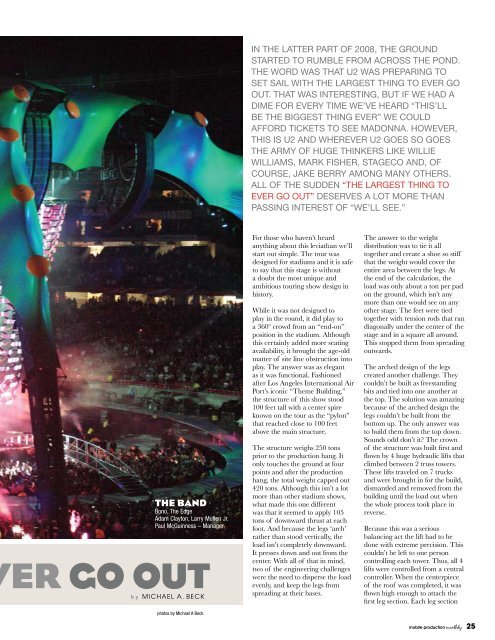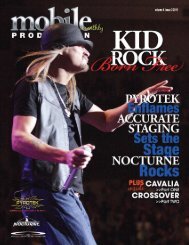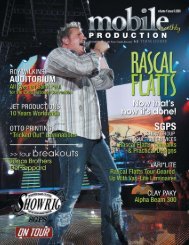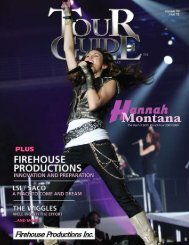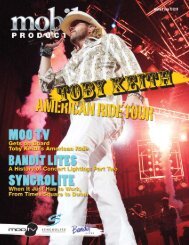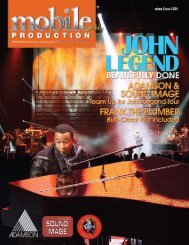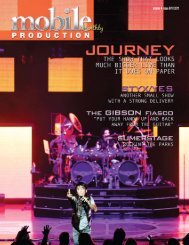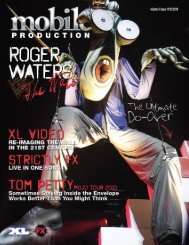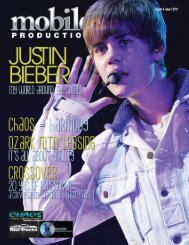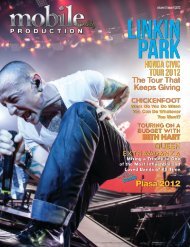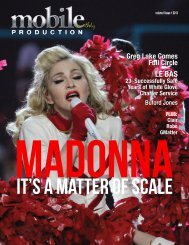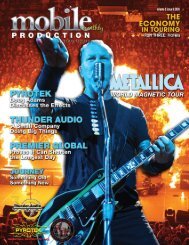volume 2 issue 12 2009 - Mobile Production Pro
volume 2 issue 12 2009 - Mobile Production Pro
volume 2 issue 12 2009 - Mobile Production Pro
Create successful ePaper yourself
Turn your PDF publications into a flip-book with our unique Google optimized e-Paper software.
In the latter part of 2008, the groundstarted to rumble from across the pond.The word was that U2 was preparing toset sail with the largest thing to ever goout. that was interesting, but if we had adime for every time we’ve heard “this’llbe the biggest thing ever” we couldafford tickets to see Madonna. However,this is U2 and wherever U2 goes so goesthe army of huge thinkers like WillieWilliams, Mark Fisher, StageCo and, ofcourse, Jake Berry among many others.All of the sudden “the largest thing toever go out” deserves a lot more thanpassing interest of “we’ll see.”THE BANDBono, The EdgeAdam Clayton, Larry Mullen Jr.Paul McGuinness – Managerer go outby Michael A. Beckphotos by Michael A BeckFor those who haven’t heardanything about this leviathan we’llstart out simple. The tour wasdesigned for stadiums and it is safeto say that this stage is withouta doubt the most unique andambitious touring show design inhistory.While it was not designed toplay in the round, it did play toa 360º crowd from an “end-on”position in the stadium. Althoughthis certainly added more seatingavailability, it brought the age-oldmatter of site line obstruction intoplay. The answer was as elegantas it was functional. Fashionedafter Los Angeles International AirPort’s iconic “Theme Building,”the structure of this show stood100 feet tall with a center spireknown on the tour as the “pylon”that reached close to 100 feetabove the main structure.The structure weighs 250 tonsprior to the production hang. Itonly touches the ground at fourpoints and after the productionhang, the total weight capped out420 tons. Although this isn’t a lotmore than other stadium shows,what made this one differentwas that it seemed to apply 105tons of downward thrust at eachfoot. And because the legs ‘arch’rather than stood vertically, theload isn’t completely downward.It presses down and out from thecenter. With all of that in mind,two of the engineering challengeswere the need to disperse the loadevenly, and keep the legs fromspreading at their bases.The answer to the weightdistribution was to tie it alltogether and create a shoe so stiffthat the weight would cover theentire area between the legs. Atthe end of the calculation, theload was only about a ton per padon the ground, which isn’t anymore than one would see on anyother stage. The feet were tiedtogether with tension rods that randiagonally under the center of thestage and in a square all around.This stopped them from spreadingoutwards.The arched design of the legscreated another challenge. Theycouldn’t be built as freestandingbits and tied into one another atthe top. The solution was amazingbecause of the arched design thelegs couldn’t be built from thebottom up. The only answer wasto build them from the top down.Sounds odd don’t it? The crownof the structure was built first andflown by 4 huge hydraulic lifts thatclimbed between 2 truss towers.These lifts traveled on 7 trucksand were brought in for the build,dismantled and removed from thebuilding until the load out whenthe whole process took place inreverse.Because this was a seriousbalancing act the lift had to bedone with extreme precision. Thiscouldn’t be left to one personcontrolling each tower. Thus, all 4lifts were controlled from a centralcontroller. When the centerpieceof the roof was completed, it wasflown high enough to attach thefirst leg section. Each leg sectionmobile production monthly 25


